2022 KIA NIRO HYBRID EV steering wheel
[x] Cancel search: steering wheelPage 531 of 684
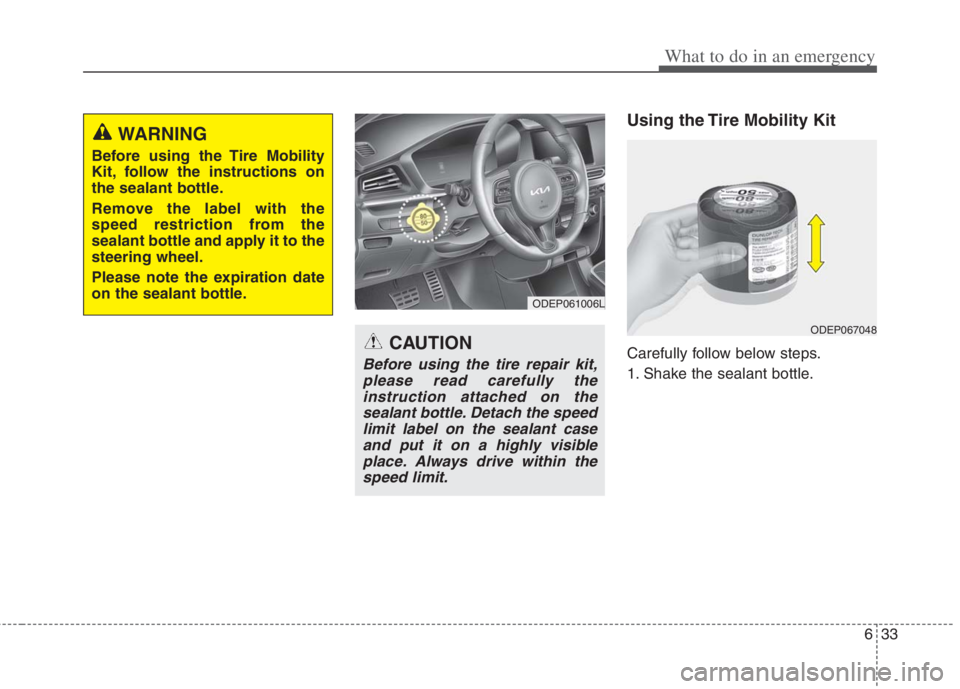
633
What to do in an emergency
Using the Tire Mobility Kit
Carefully follow below steps.
1. Shake the sealant bottle.
ODEP061006L
ODEP067048
WARNING
Before using the Tire Mobility
Kit, follow the instructions on
the sealant bottle.
Remove the label with the
speed restriction from the
sealant bottle and apply it to the
steering wheel.
Please note the expiration date
on the sealant bottle.
CAUTION
Before using the tire repair kit,
please read carefully the
instruction attached on the
sealant bottle. Detach the speed
limit label on the sealant case
and put it on a highly visible
place. Always drive within the
speed limit.
Page 539 of 684
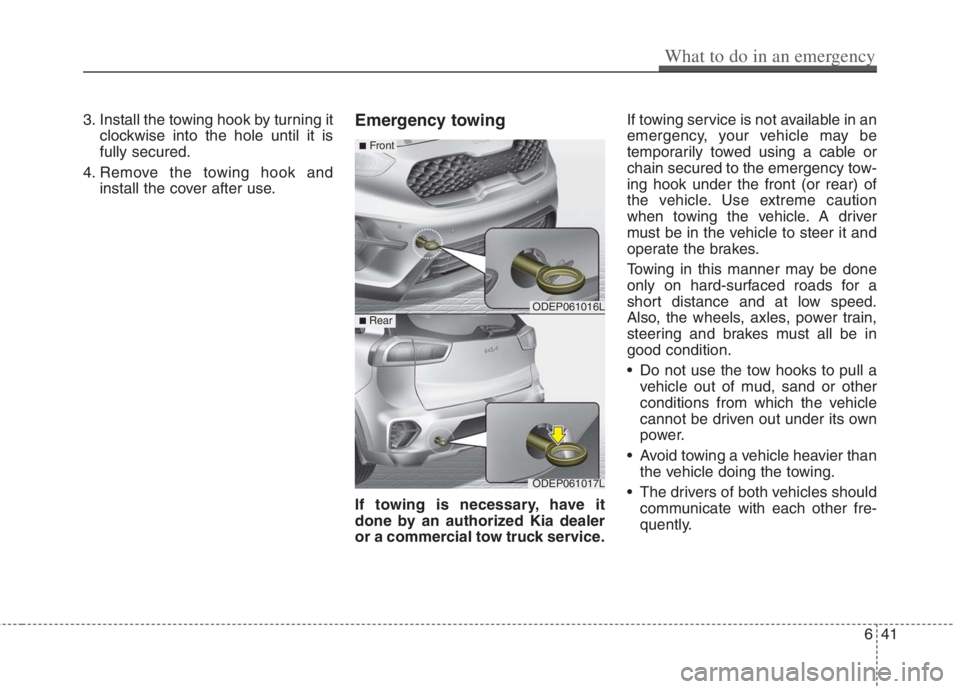
3. Install the towing hook by turning it
clockwise into the hole until it is
fully secured.
4. Remove the towing hook and
install the cover after use.Emergency towing
If towing is necessary, have it
done by an authorized Kia dealer
or a commercial tow truck service.If towing service is not available in an
emergency, your vehicle may be
temporarily towed using a cable or
chain secured to the emergency tow-
ing hook under the front (or rear) of
the vehicle. Use extreme caution
when towing the vehicle. A driver
must be in the vehicle to steer it and
operate the brakes.
Towing in this manner may be done
only on hard-surfaced roads for a
short distance and at low speed.
Also, the wheels, axles, power train,
steering and brakes must all be in
good condition.
Do not use the tow hooks to pull a
vehicle out of mud, sand or other
conditions from which the vehicle
cannot be driven out under its own
power.
Avoid towing a vehicle heavier than
the vehicle doing the towing.
The drivers of both vehicles should
communicate with each other fre-
quently.
ODEP061016L
ODEP061017L
■Front
■ Rear
What to do in an emergency
41 6
Page 541 of 684
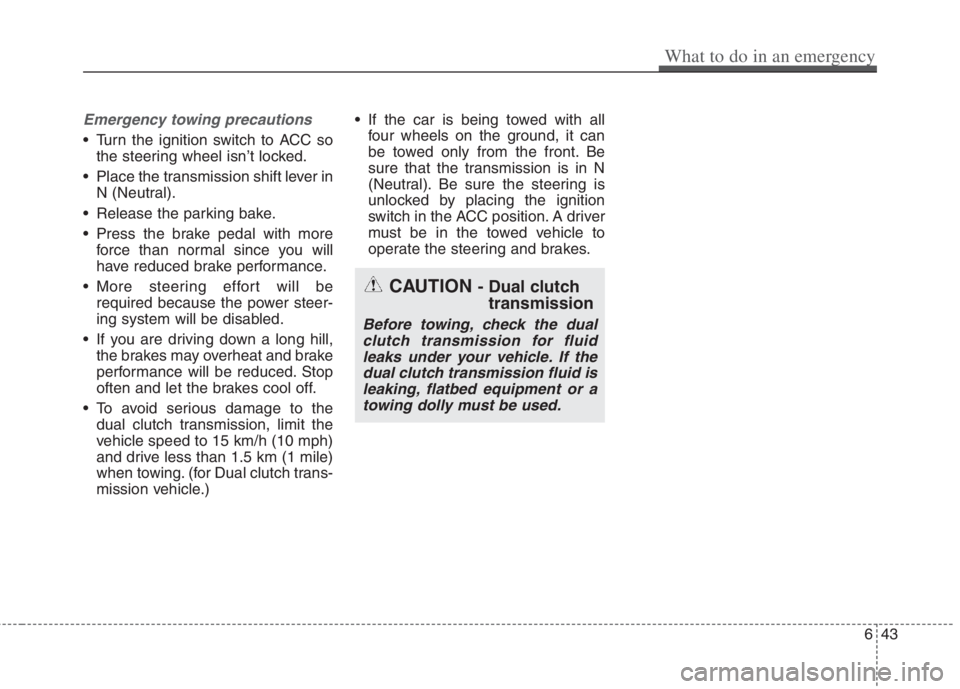
Emergency towing precautions
Turn the ignition switch to ACC so
the steering wheel isn’t locked.
Place the transmission shift lever in
N (Neutral).
Release the parking bake.
Press the brake pedal with more
force than normal since you will
have reduced brake performance.
More steering effort will be
required because the power steer-
ing system will be disabled.
If you are driving down a long hill,
the brakes may overheat and brake
performance will be reduced. Stop
often and let the brakes cool off.
To avoid serious damage to the
dual clutch transmission, limit the
vehicle speed to 15 km/h (10 mph)
and drive less than 1.5 km (1 mile)
when towing. (for Dual clutch trans-
mission vehicle.) If the car is being towed with all
four wheels on the ground, it can
be towed only from the front. Be
sure that the transmission is in N
(Neutral). Be sure the steering is
unlocked by placing the ignition
switch in the ACC position. A driver
must be in the towed vehicle to
operate the steering and brakes.
CAUTION - Dual clutch
transmission
Before towing, check the dual
clutch transmission for fluid
leaks under your vehicle. If the
dual clutch transmission fluid is
leaking, flatbed equipment or a
towing dolly must be used.
What to do in an emergency
43 6
Page 549 of 684
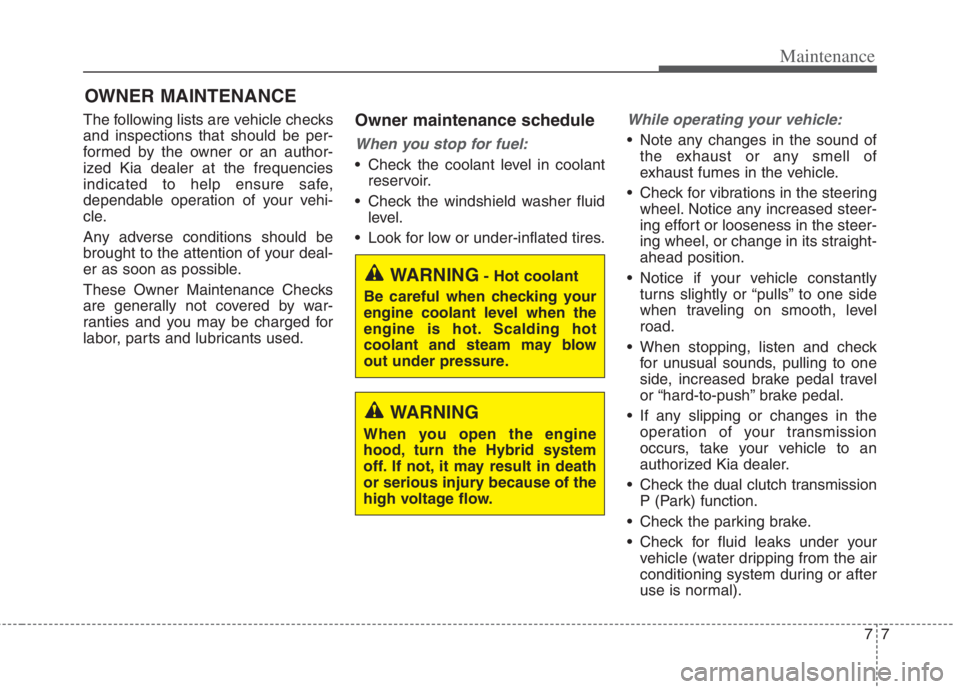
77
Maintenance
OWNER MAINTENANCE
The following lists are vehicle checks
and inspections that should be per-
formed by the owner or an author-
ized Kia dealer at the frequencies
indicated to help ensure safe,
dependable operation of your vehi-
cle.
Any adverse conditions should be
brought to the attention of your deal-
er as soon as possible.
These Owner Maintenance Checks
are generally not covered by war-
ranties and you may be charged for
labor, parts and lubricants used.Owner maintenance schedule
When you stop for fuel:
Check the coolant level in coolant
reservoir.
Check the windshield washer fluid
level.
Look for low or under-inflated tires.
While operating your vehicle:
Note any changes in the sound of
the exhaust or any smell of
exhaust fumes in the vehicle.
Check for vibrations in the steering
wheel. Notice any increased steer-
ing effort or looseness in the steer-
ing wheel, or change in its straight-
ahead position.
Notice if your vehicle constantly
turns slightly or “pulls” to one side
when traveling on smooth, level
road.
When stopping, listen and check
for unusual sounds, pulling to one
side, increased brake pedal travel
or “hard-to-push” brake pedal.
If any slipping or changes in the
operation of your transmission
occurs, take your vehicle to an
authorized Kia dealer.
Check the dual clutch transmission
P (Park) function.
Check the parking brake.
Check for fluid leaks under your
vehicle (water dripping from the air
conditioning system during or after
use is normal).
WARNING- Hot coolant
Be careful when checking your
engine coolant level when the
engine is hot. Scalding hot
coolant and steam may blow
out under pressure.
WARNING
When you open the engine
hood, turn the Hybrid system
off. If not, it may result in death
or serious injury because of the
high voltage flow.
Page 560 of 684
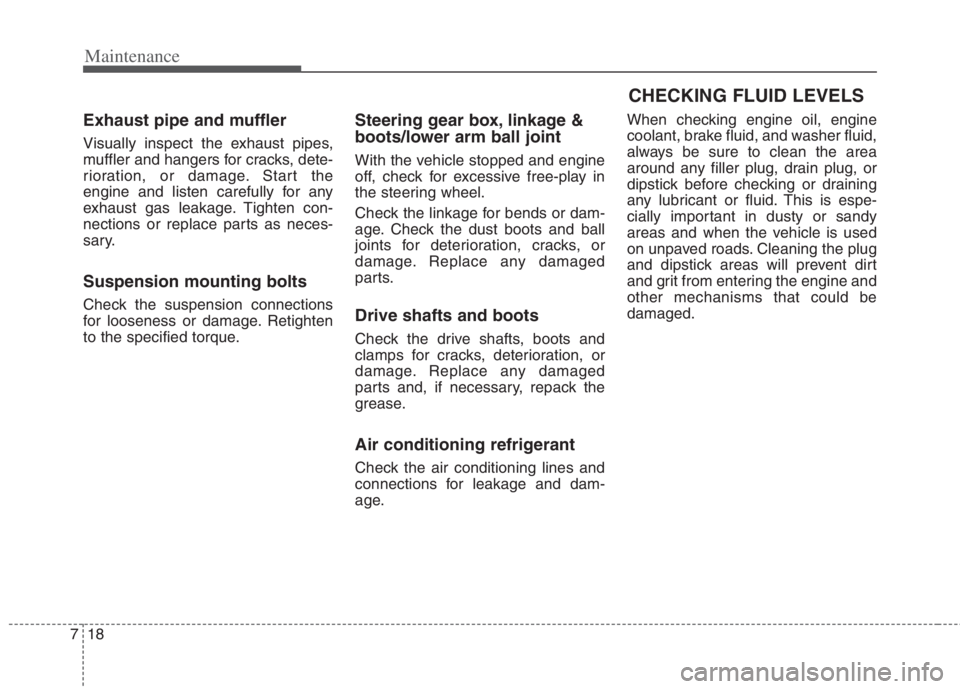
Maintenance
18 7
Exhaust pipe and muffler
Visually inspect the exhaust pipes,
muffler and hangers for cracks, dete-
rioration, or damage. Start the
engine and listen carefully for any
exhaust gas leakage. Tighten con-
nections or replace parts as neces-
sary.
Suspension mounting bolts
Check the suspension connections
for looseness or damage. Retighten
to the specified torque.
Steering gear box, linkage &
boots/lower arm ball joint
With the vehicle stopped and engine
off, check for excessive free-play in
the steering wheel.
Check the linkage for bends or dam-
age. Check the dust boots and ball
joints for deterioration, cracks, or
damage. Replace any damaged
parts.
Drive shafts and boots
Check the drive shafts, boots and
clamps for cracks, deterioration, or
damage. Replace any damaged
parts and, if necessary, repack the
grease.
Air conditioning refrigerant
Check the air conditioning lines and
connections for leakage and dam-
age.When checking engine oil, engine
coolant, brake fluid, and washer fluid,
always be sure to clean the area
around any filler plug, drain plug, or
dipstick before checking or draining
any lubricant or fluid. This is espe-
cially important in dusty or sandy
areas and when the vehicle is used
on unpaved roads. Cleaning the plug
and dipstick areas will prevent dirt
and grit from entering the engine and
other mechanisms that could be
damaged.
CHECKING FLUID LEVELS
Page 654 of 684
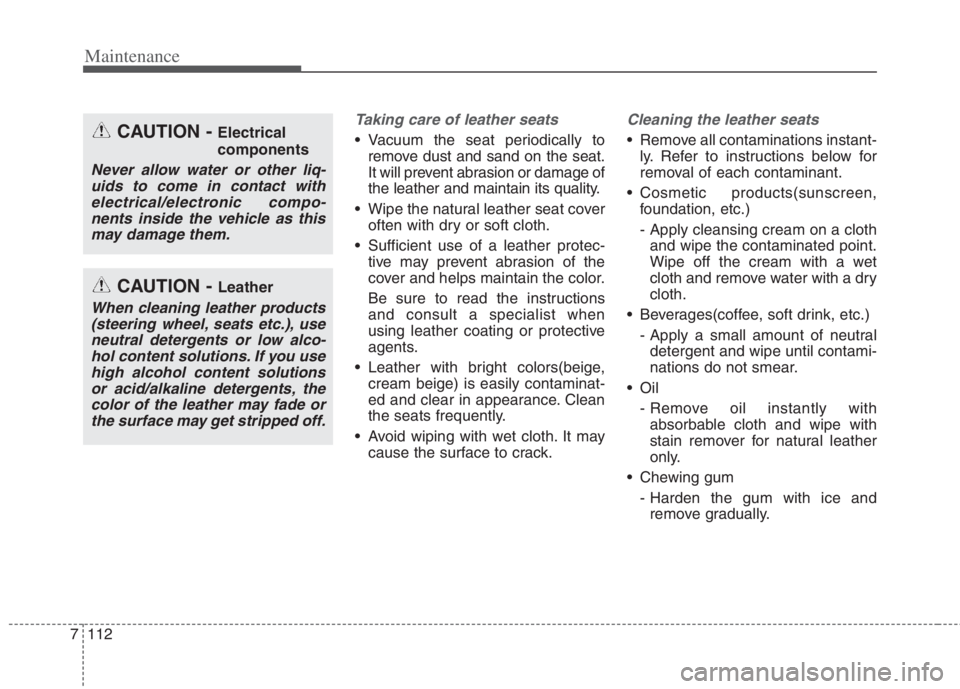
Maintenance
112 7
Taking care of leather seats
Vacuum the seat periodically to
remove dust and sand on the seat.
It will prevent abrasion or damage of
the leather and maintain its quality.
Wipe the natural leather seat cover
often with dry or soft cloth.
Sufficient use of a leather protec-
tive may prevent abrasion of the
cover and helps maintain the color.
Be sure to read the instructions
and consult a specialist when
using leather coating or protective
agents.
Leather with bright colors(beige,
cream beige) is easily contaminat-
ed and clear in appearance. Clean
the seats frequently.
Avoid wiping with wet cloth. It may
cause the surface to crack.
Cleaning the leather seats
Remove all contaminations instant-
ly. Refer to instructions below for
removal of each contaminant.
Cosmetic products(sunscreen,
foundation, etc.)
- Apply cleansing cream on a cloth
and wipe the contaminated point.
Wipe off the cream with a wet
cloth and remove water with a dry
cloth.
Beverages(coffee, soft drink, etc.)
- Apply a small amount of neutral
detergent and wipe until contami-
nations do not smear.
Oil
- Remove oil instantly with
absorbable cloth and wipe with
stain remover for natural leather
only.
Chewing gum
- Harden the gum with ice and
remove gradually.CAUTION - Electrical
components
Never allow water or other liq-
uids to come in contact with
electrical/electronic compo-
nents inside the vehicle as this
may damage them.
CAUTION - Leather
When cleaning leather products
(steering wheel, seats etc.), use
neutral detergents or low alco-
hol content solutions. If you use
high alcohol content solutions
or acid/alkaline detergents, the
color of the leather may fade or
the surface may get stripped off.
Page 682 of 684
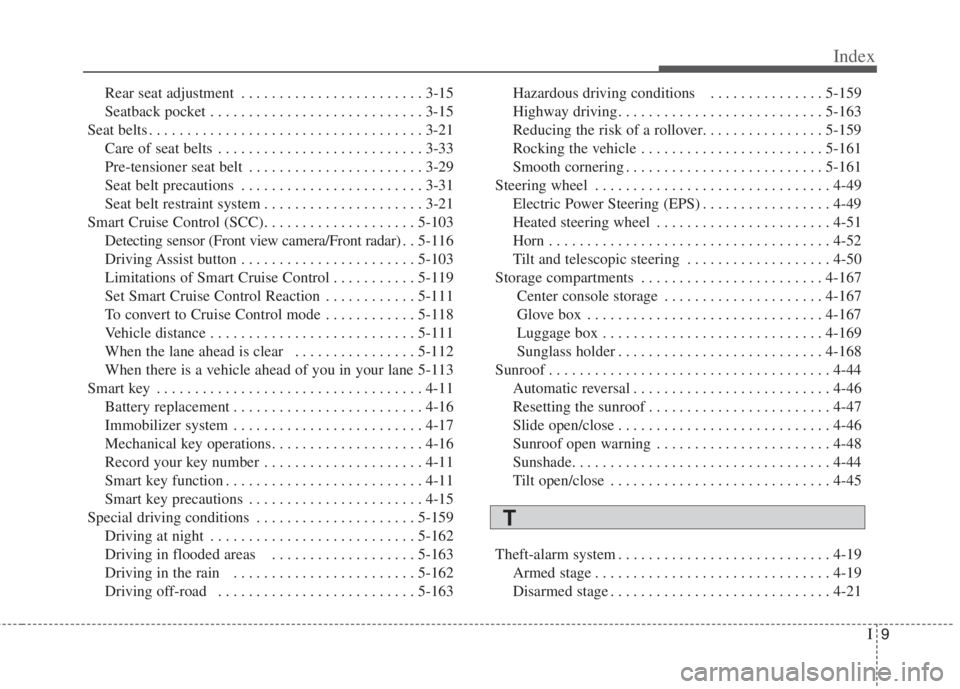
I9
Index
Rear seat adjustment . . . . . . . . . . . . . . . . . . . . . . . . 3-15
Seatback pocket . . . . . . . . . . . . . . . . . . . . . . . . . . . . 3-15
Seat belts . . . . . . . . . . . . . . . . . . . . . . . . . . . . . . . . . . . . 3-21
Care of seat belts . . . . . . . . . . . . . . . . . . . . . . . . . . . 3-33
Pre-tensioner seat belt . . . . . . . . . . . . . . . . . . . . . . . 3-29
Seat belt precautions . . . . . . . . . . . . . . . . . . . . . . . . 3-31
Seat belt restraint system . . . . . . . . . . . . . . . . . . . . . 3-21
Smart Cruise Control (SCC). . . . . . . . . . . . . . . . . . . . 5-103
Detecting sensor (Front view camera/Front radar) . . 5-116
Driving Assist button . . . . . . . . . . . . . . . . . . . . . . . 5-103
Limitations of Smart Cruise Control . . . . . . . . . . . 5-119
Set Smart Cruise Control Reaction . . . . . . . . . . . . 5-111
To convert to Cruise Control mode . . . . . . . . . . . . 5-118
Vehicle distance . . . . . . . . . . . . . . . . . . . . . . . . . . . 5-111
When the lane ahead is clear . . . . . . . . . . . . . . . . 5-112
When there is a vehicle ahead of you in your lane 5-113
Smart key . . . . . . . . . . . . . . . . . . . . . . . . . . . . . . . . . . . 4-11
Battery replacement . . . . . . . . . . . . . . . . . . . . . . . . . 4-16
Immobilizer system . . . . . . . . . . . . . . . . . . . . . . . . . 4-17
Mechanical key operations. . . . . . . . . . . . . . . . . . . . 4-16
Record your key number . . . . . . . . . . . . . . . . . . . . . 4-11
Smart key function . . . . . . . . . . . . . . . . . . . . . . . . . . 4-11
Smart key precautions . . . . . . . . . . . . . . . . . . . . . . . 4-15
Special driving conditions . . . . . . . . . . . . . . . . . . . . . 5-159
Driving at night . . . . . . . . . . . . . . . . . . . . . . . . . . . 5-162
Driving in flooded areas . . . . . . . . . . . . . . . . . . . 5-163
Driving in the rain . . . . . . . . . . . . . . . . . . . . . . . . 5-162
Driving off-road . . . . . . . . . . . . . . . . . . . . . . . . . . 5-163Hazardous driving conditions . . . . . . . . . . . . . . . 5-159
Highway driving . . . . . . . . . . . . . . . . . . . . . . . . . . . 5-163
Reducing the risk of a rollover. . . . . . . . . . . . . . . . 5-159
Rocking the vehicle . . . . . . . . . . . . . . . . . . . . . . . . 5-161
Smooth cornering . . . . . . . . . . . . . . . . . . . . . . . . . . 5-161
Steering wheel . . . . . . . . . . . . . . . . . . . . . . . . . . . . . . . 4-49
Electric Power Steering (EPS) . . . . . . . . . . . . . . . . . 4-49
Heated steering wheel . . . . . . . . . . . . . . . . . . . . . . . 4-51
Horn . . . . . . . . . . . . . . . . . . . . . . . . . . . . . . . . . . . . . 4-52
Tilt and telescopic steering . . . . . . . . . . . . . . . . . . . 4-50
Storage compartments . . . . . . . . . . . . . . . . . . . . . . . . 4-167
Center console storage . . . . . . . . . . . . . . . . . . . . . 4-167
Glove box . . . . . . . . . . . . . . . . . . . . . . . . . . . . . . . 4-167
Luggage box . . . . . . . . . . . . . . . . . . . . . . . . . . . . . 4-169
Sunglass holder . . . . . . . . . . . . . . . . . . . . . . . . . . . 4-168
Sunroof . . . . . . . . . . . . . . . . . . . . . . . . . . . . . . . . . . . . . 4-44
Automatic reversal . . . . . . . . . . . . . . . . . . . . . . . . . . 4-46
Resetting the sunroof . . . . . . . . . . . . . . . . . . . . . . . . 4-47
Slide open/close . . . . . . . . . . . . . . . . . . . . . . . . . . . . 4-46
Sunroof open warning . . . . . . . . . . . . . . . . . . . . . . . 4-48
Sunshade. . . . . . . . . . . . . . . . . . . . . . . . . . . . . . . . . . 4-44
Tilt open/close . . . . . . . . . . . . . . . . . . . . . . . . . . . . . 4-45
Theft-alarm system . . . . . . . . . . . . . . . . . . . . . . . . . . . . 4-19
Armed stage . . . . . . . . . . . . . . . . . . . . . . . . . . . . . . . 4-19
Disarmed stage . . . . . . . . . . . . . . . . . . . . . . . . . . . . . 4-21
T